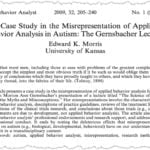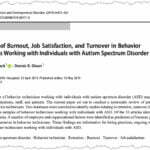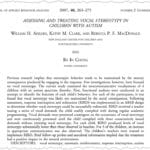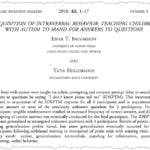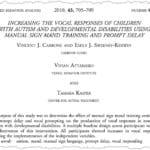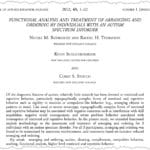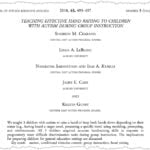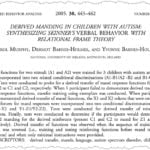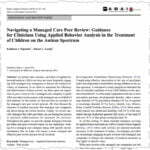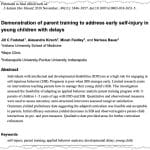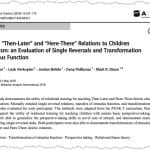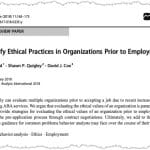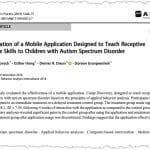Filters Sort results
Reset Apply
A Case Study in the Misrepresentation of Applied Behavior Analysis in Autism: The Gernsbacher Lectures Edward K. Morris Read the following article and pass a 15-question quiz on it:
Morris, E. K. (2009). A case study in the misrepresentation of applied behavior analysis in autism: The Gernsbacher lectures. The Behavior… Show more (+) Read the following article and pass a 15-question quiz on it:
Morris, E. K. (2009). A case study in the misrepresentation of applied behavior analysis in autism: The Gernsbacher lectures. The Behavior Analyst, 32, 205-240. Show less (-) BCBA CEUs: 3.5 3.5 | ||
Predictors of Burnout, Job Satisfaction, and Turnover in Behavior Technicians Working with Individuals with Autism Spectrum Disorder Marlena N. Novack & Dennis R. Dixon Read the following article and pass a 6-question quiz on it:
Novack, M. N., & Dixon, D. R. (2019). Predictors of burnout, job satisfaction, and turnover in behavior technicians working with… Show more (+) Read the following article and pass a 6-question quiz on it:
Novack, M. N., & Dixon, D. R. (2019). Predictors of burnout, job satisfaction, and turnover in behavior technicians working with individuals with autism spectrum disorder. Review Journal of Autism and Developmental Disorders, 6, 413-421.
Show less (-) BCBA CEUs: 1 1 | ||
Assessing and Treating Vocal Stereotypy in Children with Autism William H. Ahearn, Kathy M. Clark, Rebecca P. F. MacDonald, & Bo In Chung Read the following article and pass a 5-question quiz on it:
Ahearn, W. H., Clark, K. M., MacDonald, R. P., & Chung, B. O. (2007). Assessing and treating vocal stereotypy in… Show more (+) Read the following article and pass a 5-question quiz on it:
Ahearn, W. H., Clark, K. M., MacDonald, R. P., & Chung, B. O. (2007). Assessing and treating vocal stereotypy in children with autism. Journal of Applied Behavior Analysis, 40(2), 263-275.
Show less (-) BCBA CEUs: 1 | ||
Acquisition of Intraverbal Behavior: Teaching Children with Autism to Mand for Answers to Questions Einar T. Ingvarsson & Tatia Hollobaugh Read the following article and pass a 7-question quiz on it:
Ingvarsson, E. T., & Hollobaugh, T. (2010). Acquisition of intraverbal behavior: Teaching children with autism to mand for answers to… Show more (+) Read the following article and pass a 7-question quiz on it:
Ingvarsson, E. T., & Hollobaugh, T. (2010). Acquisition of intraverbal behavior: Teaching children with autism to mand for answers to questions. Journal of Applied Behavior Analysis, 43(1), 1-17. Show less (-) BCBA CEUs: 1.5 | ||
Increasing the Vocal Responses of Children with Autism and Developmental Disabilities Using Manual Sign Mand Training and Prompt Delay Vincent J. Carbone, Emily J. Sweeney-Kerwin, Vivian Attanasio, & Tamara Kasper Read the following article and pass a 7-question quiz on it:
Carbone, V. J., Sweeney-Kerwin, E. J., Attanasio, V., & Kasper, T. (2010). Increasing the vocal responses of children With autism… Show more (+) Read the following article and pass a 7-question quiz on it:
Carbone, V. J., Sweeney-Kerwin, E. J., Attanasio, V., & Kasper, T. (2010). Increasing the vocal responses of children With autism and developmental disabilities using manual sign mand training and prompt delay. Journal of Applied Behavior Analysis, 43(4), 705-709. Show less (-) BCBA CEUs: 0.5 | ||
Functional Analysis and Treatment of Arranging and Ordering by Individuals with an Autism Spectrum Disorder Nicole M. Rodriguez, Rachel H. Thompson, Kevin Schlichenmeyer, & Corey S. Stocco Read the following article and pass a 9-question quiz on it:
Rodriguez, N. M., Thompson, R. H., Schlichenmeyer, K., & Stocco, C. S. (2012). Functional analysis and treatment of arranging and… Show more (+) Read the following article and pass a 9-question quiz on it:
Rodriguez, N. M., Thompson, R. H., Schlichenmeyer, K., & Stocco, C. S. (2012). Functional analysis and treatment of arranging and ordering by individuals with an autism spectrum disorder. Journal of Applied Behavior Analysis, 45 (1), 1-22.
Show less (-) BCBA CEUs: 2 | ||
Teaching Effective Hand Raising to Children with Autism During Group Instruction Shaireen M. Charania, Linda A. LeBlanc, Narmatha Sabanathan, Inas A. Ktaech, James E. Carr, & Kristin Gunby Read the following article and pass a 5-question quiz on it:
Charania, S. M., LeBlanc, L. A., Sabanathan, N., Ktaech, I. A., Carr, J. E., & Gunby, K. (2010). Teaching effective… Show more (+) Read the following article and pass a 5-question quiz on it:
Charania, S. M., LeBlanc, L. A., Sabanathan, N., Ktaech, I. A., Carr, J. E., & Gunby, K. (2010). Teaching effective hand raising to children with autism during group instruction. Journal of Applied Behavior Analysis,43(3), 493-497.
Show less (-) BCBA CEUs: 0.5 | ||
On the Use of Fluency Training in the Behavioral Treatment of Autism: A Commentary Megan R. Heinicke, James E. Carr, Linda A. LeBlanc, & Jamie M. Severtson Read the following article and pass a 5-question quiz on it:
Heinicke, M. R., Carr, J. E., LeBlanc, L. A., & Severtson, J. M. (2010). On the use of fluency training… Show more (+) Read the following article and pass a 5-question quiz on it:
Heinicke, M. R., Carr, J. E., LeBlanc, L. A., & Severtson, J. M. (2010). On the use of fluency training in the behavioral treatment of autism: A commentary. The Behavior Analyst, 33(2), 223-229. Show less (-) BCBA CEUs: 0.5 | ||
Derived Manding in Children with Autism: Synthesizing Skinner’s Verbal Behavior with Relational Frame Theory Carol Murphy, Dermot Barnes-Holmes, & Yvonne Barnes-Holmes Read the following article and pass a 6-question quiz on it:
Murphy, C., Barnes-Holmes, D., & Barnes-Holmes, Y. (2005). Derived manding in children with autism: Synthesizing Skinner’s Verbal Behavior with relational frame theory. Journal… Show more (+) Read the following article and pass a 6-question quiz on it:
Murphy, C., Barnes-Holmes, D., & Barnes-Holmes, Y. (2005). Derived manding in children with autism: Synthesizing Skinner’s Verbal Behavior with relational frame theory. Journal of Applied Behavior Analysis, 38(4), 445-462.
Show less (-) BCBA CEUs: 1 | ||
Navigating a Managed Care Peer Review Kathleen J. Papatola & Stuart L. Lustig Read the following article and pass an 8-question quiz on it:
Papatola, K. J., & Lustig, S. L. (2016). Navigating a managed care peer review: Guidance for clinicians using applied behavior… Show more (+) Read the following article and pass an 8-question quiz on it:
Papatola, K. J., & Lustig, S. L. (2016). Navigating a managed care peer review: Guidance for clinicians using applied behavior analysis in the treatment of children on the autism spectrum. Behavior Analysis in Practice, 9, 135-145. Show less (-) BCBA CEUs: 1.5 | ||
Read the following article and pass a 5-question quiz on it:
Brodhead, M. T. (2015). Maintaining professional relationships in an interdisciplinary setting: Strategies for navigating nonbehavioral treatment recommendations for individuals with… Show more (+) Read the following article and pass a 5-question quiz on it:
Brodhead, M. T. (2015). Maintaining professional relationships in an interdisciplinary setting: Strategies for navigating nonbehavioral treatment recommendations for individuals with autism. Behavior Analysis in Practice, 8, 70-78. Show less (-) BCBA CEUs: 0.5 0.5 | ||
Demonstration of Parent Training to Address Early Self-Injury in Young Children with Delays Jill Fodstad, Alexandra Kirsch, Micah Faidley, & Nerissa Bauer Read the following article and pass a 6-question quiz on it:
Fodstad, J. C., Kirsch, A., Faidley, M., & Bauer, N. (2018). Demonstration of parent training to address early self-injury in
young… Show more (+) Read the following article and pass a 6-question quiz on it:
Fodstad, J. C., Kirsch, A., Faidley, M., & Bauer, N. (2018). Demonstration of parent training to address early self-injury in
young children with delays. Journal of Autism and Developmental Disorders, 48(11), 3846-3857. Show less (-) BCBA CEUs: 1 | ||
Teaching “Then-Later” and “Here-There” Relations to Children with Autism: An Evaluation of Single Reversals and Transformation of Stimulus Function Becky Barron, Leah Verkuylen, Jordan Belisle, Dana Paliliunas, & Mark Dixon Read the following article and pass a 9-question quiz on it:
Barron, B. F., Verkuylen, L., Belisle, J., Paliliunas, D., & Dixon, M. R. (2019). Teaching "then-later" and "here-there" relations to… Show more (+) Read the following article and pass a 9-question quiz on it:
Barron, B. F., Verkuylen, L., Belisle, J., Paliliunas, D., & Dixon, M. R. (2019). Teaching "then-later" and "here-there" relations to children with autism: An evaluation of single reversals and transformation of stimulus function. Behavior Analysis in Practice, 12, 167-175. Show less (-) BCBA CEUs: 1 | ||
How to Identify Ethical Practices in Organizations Prior to Employment Matthew Brodhead, Shawn Quigley, & David Cox Read the following article and pass a 5-question quiz on it:
Brodhead, M. T., Quigley, S. P., & Cox, D. J. (2018). How to identify ethical practices in organizations prior to… Show more (+) Read the following article and pass a 5-question quiz on it:
Brodhead, M. T., Quigley, S. P., & Cox, D. J. (2018). How to identify ethical practices in organizations prior to employment. Behavior Analysis in Practice, 11, 165-173. Show less (-) BCBA CEUs: 1 1 | ||
An Evaluation of a Mobile Application Designed to Teach Receptive Language Skills to Children with Autism Spectrum Disorder Marlena Novack, Esther Hong, Dennis Dixon, & Doreen Granpeesheh Read the following article and pass a 6-question quiz on it:
Novack, M. N., Hong, E., Dixon, D. R., & Granpeesheh, D. (2019). An evaluation of a mobile application designed to… Show more (+) Read the following article and pass a 6-question quiz on it:
Novack, M. N., Hong, E., Dixon, D. R., & Granpeesheh, D. (2019). An evaluation of a mobile application designed to teach receptive
language skills to children with autism spectrum disorder. Behavior Analysis in Practice, 12, 66-77. Show less (-) BCBA CEUs: 1 |

